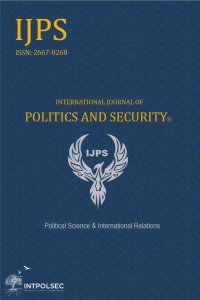Analysis of the Intra-State Conflict in Afghanistan
Afganistan, Devlet-içi çatışma, 9/11, Uluslararası güçler, Taliban
Analysis of the Intra-State Conflict in Afghanistan
Afghanistan, Intra-State Conflict, 9/11, International Actors, Taliban,
___
- Afghanistan: 10,000 civilian casualties in 2017: United Nations Assistance Mission in Afghanistan (UNAMA), February 15, 2018, https://unama.unmissions.org/afghanistan-10000-civilian-casualties-2017-un-report-suicide-attacks-and-ieds-caused-high-number (Accessed: 20.07.2019).
- Aljazeera Afghan civilian casualties at record high in 2016: UN. February 06, 2017, https://www.aljazeera.com/news/2017/02/afghan-civilian-casualties-2016-170206062807210.html (Accessed: 20.07.2019).
- Australian Government, “Afghanistan: Political Parties and Insurgent Groups 1978-2001,” Migration Review Tribunal-Refugee Review Tribunal, March 7, 2013, https://www.ecoi.net/en/file/local/1154721/1226_1369733568_ppig1.pdf (Accessed: 29.04. 2019).
- Brisson, Katherine. "International Intervention in Bosnia-Herzegovina and Macedonia from the 1990s Through the 2000's" Syracuse University Honors Program Capstone Projects. 1004. (2017): 22. https://surface.syr.edu/honors_capstone/1004 (Accessed: 13.03. 2019).
- Brzezinski, Zbigniew. The Grand Chessboard, American Primacy and its Geostrategic Imperatives. (United States: Basic Books, 1997), 7.
- ___________, “Afghanistan in 1995: Civil War and a Mini-Great Game,” Asian Survey 36, no. 2, (February 1996): 190-195.
- Butt, Khalid Manzoor, Siddqi, Azhar Javed. “Pakistan-Afghanistan Relations from 1978 to 2001: An Analysis,” South Asian Studies 31, no. 2, (July—December 2016): 723-744.
- Civilian deaths from Afghan conflict in 2018 at highest recorded level-UN report: United Nations Assistance Mission in Afghanistan (UNAMA), February 24, 2019, https://unama.unmissions.org/civilian-deaths-afghan-conflict-2018-highest-recorded-level-%E2%80%93-un-report (Accessed: 2007.2019).
- Clinton, Hillary Rodham. Hard Choices (London: Simon and Schuster, 2014), 164.
- Coll, Steve. Ghost Wars: The Secret History of the CIA, Afghanistan and Bin Laden, From the Soviet Invasion to September 10, 2001 (London: Penguin Books, 2005), 46.
- Compartim, Programa. Conflict Mapping: Theory and Methodology, Practical Application in Juvenile Justice (Department of Justicia, 2014), 20.
- Dixit, Aabha. “The Afghan Civil War: Emergence of the Taliban as Power Broker,” South Asian Survey 2, no. 1, (1995): 111-118.
- Durant, Will. “Civil War in Afghanistan.” www.socialstudies.org/sites/default/files/publications/se/6507/650706.html (Accessed: 27.04.2019).
- Friedman, George. “The 30-Year War in Afghanistan,” Geopolitical Weekly (Stratfor), June 29, 2010, https://worldview.stratfor.com/article/30-year-war-afghanistan (Accessed: 06.05. 2019).
- Gall, Carlotta. The Wrong Enemy: America in Afghanistan 2001-2014 (New York: Houghton Mifflin Harcourt, 2014), 242-243.
- Hilali, A. Z. US Pakistan Relationship: Soviet Invasion of Afghanistan (Great Britain: Ashgate Publishing Limited, 2005), 70.
- Huria, Sonali. “Failed States and Foreign Military Intervention: The Afghanistan Imbroglio,” IPCS Special Report, no. 67 (2009).
- Katzman, Kenneth. “Afghanistan: Post-War Governance, Security, and U.S. Policy,” CRS Report for US Congress,” (March 25, 2004), 9.
- Khalilzad, Zalmay. “Afghanistan in 1994: Civil War and Disintegration,” Asian Survey 35, no. 2, (February 1995): 147-152.
- Maass, Citha D. “The Afghanistan Conflict: External Involvement,” Central Asian Survey 18, no. 1 (1999): 65-78.
- Matinuddin, Kamal. The Taliban Phenomenon: Afghanistan 1994-1997 (New Delhi: Lancer Publishers, 2000), 12.
- National Commission on Terrorist Attacks Upon the United States, “9/11 Commission Report,” p. 330, https://9-11commission.gov/report/ (Accessed: 10.05.2019).
- NATO Chicago Summit Declaration on Afghanistan, May 21, 2012, www.nato.int/cps/en/natolive/official_texts_87595.htm (Accessed: 18.07.2019).
- NATO Lisbon Summit Declaration, November 20, 2010, www.nato.int/cps/en/natolive/official_texts_68828.htm (Accessed: 18.07.2019).
- NATO Wales Summit Declaration, September 5, 2014, www.nato.int/cps/en/natohq/official_texts_112964.htm (Accessed: 19.06.2019).
- Nojumi, Neamatollah. The Rise of the Taliban in Afghanistan: Mass Mobilization, Civil War, and the Future of the Region (New York: Palgrave, 2002), 97.
- Paliwal, Avinash. “New Alignments, Old Battlefield: Revisiting India’s Role in Afghanistan,” Carnegie India, June 15, 2017, https://carnegieindia.org/2017/06/15/new-alignments-old-battlefield-revisiting-india-s-role-in-afghanistan-pub-71272 (Accessed: 02.05. 2019).
- Reuveny, Rafael. and Prakash, Aseem. “The Afghanistan war and the Breakdown of the Soviet Union,” Review of International Studies 24, no. 04, (October 1999): 693-708.
- Shroder, John F. Natural Resources in Afghanistan: Geographic and Geologic Perspectives on Centuries of Conflict (USA: Elsevier, 2014), 10.
- Tarzi, Shah M. “Afghanistan in 1992: A Hobbesian State of Nature,” Asian Survey 33, no. 2, (February 1993): 165-174.
- Wildman, David and Bennis, Phyllis. “The War in Afghanistan Goes Global,” Critical Asian Studies 42, no. 3 (2010): 469-480.
- Yegorov, Oleg. “Why did the USSR enter Afghanistan,” Russia Beyond, February 05, 2019. https://www.rbth.com/history/329948-why-did-ussr-enter-afghanistan-war (Accessed: 09.07.2019).
- Yilmaz, Muzaffer Ercan. “Intra-State Conflicts in the Post-Cold War Era,” International Journal on World Peace 24, no. 4, (December 2007): 11-33.
- ISSN: 2667-8268
- Yayın Aralığı: Yılda 2 Sayı
- Başlangıç: 2019
- Yayıncı: Fikret BİRDİŞLİ
Drivers of Political Radicalization and De-radicalization of Terrorism in Northern Nigeria
Komünizm Sonrası İslam:Orta Asya'da Din ve Politika (Kitap İncelemesi)
Analysis of the Intra-State Conflict in Afghanistan
President Rodrigo Duterte and the Birth of Radical Democracy in the Philippines
Redouane TOUATI, Halima TOUATI
Evaluation of Developments in Afghanistan in the Context of Foreign Policy and Security Issues
Hasan ACAR, Mustafa PEKCANDANOĞLU
